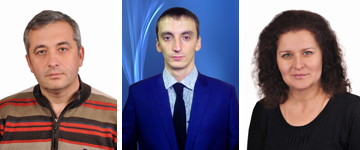Abstract
The article is devoted to the research of a problem of the application of computer algebra systems in the course of skill training of future mathematics teachers. The possibility of study organization for students of pedagogical institutions of higher education receiving "014 secondary education (mathematics)" speciality with the use of computer algebra systems is considered. The term "computer algebra system" is understood as the software which is intended for the solving of various mathematical tasks by means of a computer with a possibility of visualization of all stages of calculations. Proceeding from the fact that the computer algebra systems are actively used in educational process all over the world and informational educational environments in the course of teaching mathematical disciplines are created on their basis, it is possible to make a conclusion that the computer algebra systems are very important components of the process of training future experts. The current state of the problem of introduction and application of the computer algebra systems in the training of future mathematics teachers is investigated. The role of the computer algebra systems in teaching mathematics subjects and general natural sciences in pedagogical establishments of higher education is defined. Such computer algebra systems as MathCAD, MatLab, Maple, Mathematica, Maxima, SAGE, and Axiom are marked out among the most modern and successfully used systems aimed at solving mathematical tasks. Arguments in favour of the use of the free computer algebra system Maxima in educational and scientific activity of students are adduced in the article. Its main advantages and disadvantages are presented. The main functional of this system is considered which allows to optimize the time of the solution of various mathematical tasks, to adjust a conclusion of the received result, to perform staged verification of correctness of calculations.References
J. Cha and B. Koo "ICTs for new Engineering Education", Policy Brief, February 2011: UNESCO, 2011, 11 p.(in English)
O.V. Spivakovskyi, "Theory and practice of using informational technologies in the process of training of students with mathematical specialties": monograph, Kherson: Ailant, 2003. (in Ukrainian)
K.I. Slovak, "Information and communication technologies of activating educational and cognitive activity of students", Scientific Bulletin of Donbas, № 3, 2011. [online]. Available: http://nbuv.gov.ua/UJRN/nvd_2011_3_13. Accessed on: Mar. 03, 2018. (in Ukrainian)
U.P. Kohut та M.P. Shyshkіna, "Methodological aspects of using the Maxima system as a means of fundamentalizing the education of bachelors of computer science", Information Technologies in Education, № 20, pp. 74-83, 2014. (in Ukrainian)
M.P. Shyshkina, U.P. Kohut "The use of the cloud-based learning component with the maxima system for teaching operations research", Information Technologies and Learning Tools, Vol 57, № 1, pp. 154-172, 2017. (in Ukrainian)
M.I. Zhaldak, "The pedagogical potential of computer-based systems of teaching mathematics", Computer-oriented training system, № 7, pp 3-16, 2003. (in Ukrainian)
Yu.S. Ramskyi, "Information society. Informatization of education", Computer-based learning systems, № 7, pp. 16-28, 2003. (in Russian)
V.E. Velychko "Theoretical and methodical principles of the use of free software in the preparation of future teachers of mathematics, physics and computer science": monograph, Sloviansk: Entrepreneur Matorin B.I., 2017. (in Ukrainian)
Yu.I. Sinko, "Systems of Computer Mathematics and their role in mathematical education", Information technology in education, № 3, pp. 274-278, 2009. (in Ukrainian)
Yu.V. Trius, "Computer-oriented teaching of mathematics learning": monograph, Cherkasy Gate-Ukraine, 2005. (in Ukrainian)
N.V. Filipova, "The use of computer systems of mathematics and computer science at the study subjects, higher mathematics as one kind of technology pedagogical", Young Scientist, № 7, pp. 254-259, 2009. (in Russian)
V.P. Diakonov, Computer Mathematics. Theory and practice. Moscow, Russia: NOWLEDGE, 2001. (in Russian)
E.A. Chychkarov, Computer Mathematics with Maxima: A Guide for School Students and Students. Moscow, Russia: ALT Linux, 2012. (in Russian)
A.V. Stopkin, D.Yu. Lukianova, "Use of the system of computer mathematics in teaching of exact sciences", Personality Spirituality: Methodology, Theory and Practice, № 2 (71), pp. 190-196, 2016. (in Ukrainian)
T.P. Kobylnyk, U. Kohut "Systems of computer mathematics in the training of students of the direction of training "Informatics"", Information technology and learning tools, № 40, pp. 50-64, 2014. (in Ukrainian)
S. Syisoeva, and T. Kristopchuk, Methodology of scientific and pedagogical research: Textbook. Rivne, Ukraine: Volyinskie berega, 2013. (in Ukrainian)
W. Dautermann "Maxima 5.40.0 Manual", 2017. [online]. Available: http://maxima.sourceforge.net/docs/manual/maxima.html. Accessed on: Mar. 05, 2018. (in English).
N.O. Buhaiets "Maxima Software for creating graphic imaging and math studies ", Scientific Journal of Dragomanov NPU. Seiries 2. Computer-based learning systems, №15(22), с. 105-114, 2015. (in Ukrainian)
Authors who publish in this journal agree to the following terms:
- Authors hold copyright immediately after publication of their works and retain publishing rights without any restrictions.
- The copyright commencement date complies the publication date of the issue, where the article is included in.
Content Licensing
- Authors grant the journal a right of the first publication of the work under a Creative Commons Attribution-NonCommercial-ShareAlike 4.0 International License (CC BY-NC-SA 4.0) that allows others freely to read, download, copy and print submissions, search content and link to published articles, disseminate their full text and use them for any legitimate non-commercial purposes (i.e. educational or scientific) with the mandatory reference to the article’s authors and initial publication in this journal.
- Original published articles cannot be used by users (exept authors) for commercial purposes or distributed by third-party intermediary organizations for a fee.
Deposit Policy
- Authors are permitted and encouraged to post their work online (e.g., in institutional repositories or on their website) during the editorial process, as it can lead to productive exchanges, as well as earlier and greater citation of published work (see this journal’s registered deposit policy at Sherpa/Romeo directory).
- Authors are able to enter into separate, additional contractual arrangements for the non-exclusive distribution of the journal's published version of the work (e.g., post it to an institutional repository or publish it in a book), with an acknowledgement of its initial publication in this journal.
- Post-print (post-refereeing manuscript version) and publisher's PDF-version self-archiving is allowed.
- Archiving the pre-print (pre-refereeing manuscript version) not allowed.


